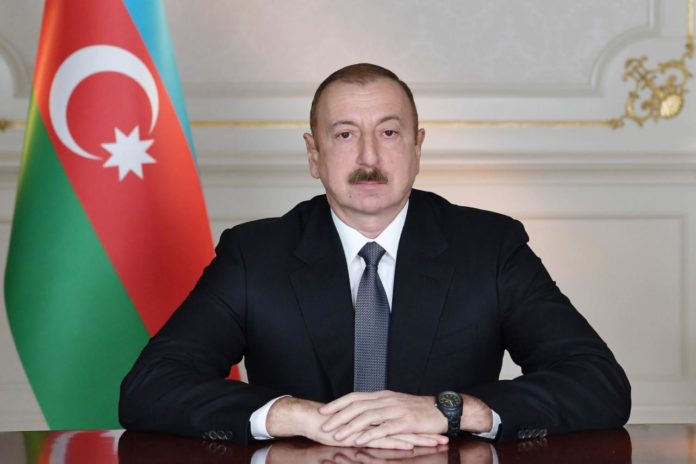The Republic of Azerbaijan has 75-80 percent GDP of South Caucasus Region (SCR). Its macro-economy is strong, stable and sustainable, its current and future prospects are very healthy in which the non-oil sector will be further productive and strengthened.
According to various published reports of IMF & World Bank (2006-2017) its national economy outperformed other regional economies i.e. GDP 34.5 25 0/0, 9.3 0/0 2010 5 0/0, 0.1 0/0, 2.2 %, 5.8 , 2.8 0/0, 1.1 %, 2.4 % and 1.4 percent during 2006, 2007, 2008, 20019, 2010, 2011, 2012, 2013, 2014, 2015, 2016, 2017 respectively. Furthermore, its GDP per capita (current prices) are USD 4,028 and GDP per capita (PPP) USD 18,179.4 which is the highest in the region and beyond. Its GDP composition is diversified because of which agriculture stands for 6.4 %, industry 61.1 % and Services 32.5 %.
State Statistics Committee (October, 2018)
According to its State Statistics Committee most recent report (October, 2018), the GDP totaled 37,009 billion manat ($21.77 billion USD) in the first half of 2018. Non-oil GDP increased by 2.0 percent while oil GDP increased by 0.1 percent in the same period compared with the first half of 2017. Furthermore, Azerbaijan’s GDP volume reached almost 37 .01 billion manat in January June 2018 that is 1.3 percent more than in January-June 2017. The volume of GDP per capita stood at 3.77 million manat.
During (January-June 2018) the volume of GDP produced by the nonoil sector of Azerbaijan increased by 2.0 percent compared to the first half of 2017, while in the oil and gas sec tor there was an increase of 0.1 percent. Upward growth was observed in all spheres of the economy. Thus, the sphere of agriculture, forestry and fisheries grew by 7.6 percent, accommodation of tourists and catering by 7.4 percent.
Figure-l
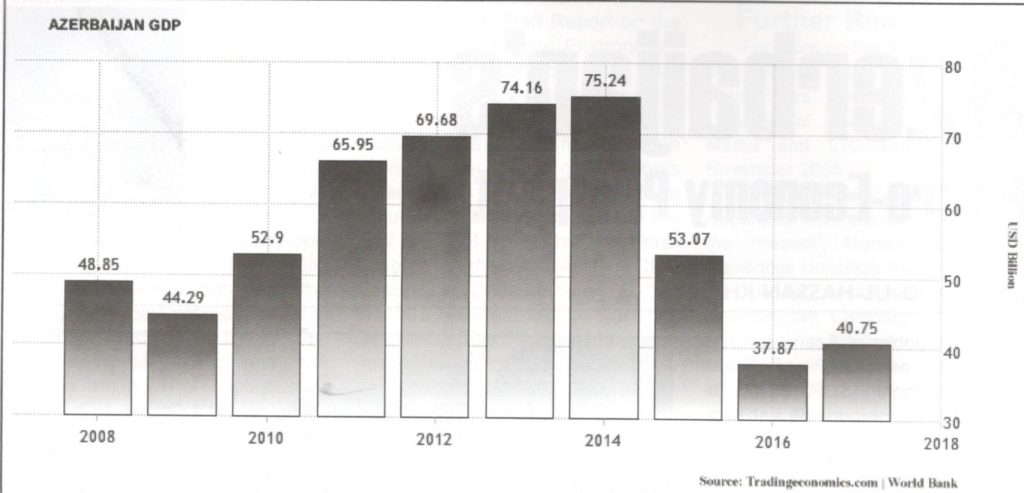
Global Competitiveness Report (October, 2018)
According to Global Competitiveness Report (October, 2018) of the World Economic Forum (WEF) Azerbaijan along with Turkey, Serbia, Georgia, South Africa and Croatia entered the list of top seventy countries which is indeed a great achievement. Successful implementation and institutionalized economic reforms are main factors of its global recognition mentioned in the most recent published report of WEF 2018.
Its competitiveness and business environment in the context of global changes and challenges have been elevated, transformed and connected. Its humanity based social policy; business friendly policies and the status of the socio-economic system supported and geared its macro-economy during (2017-18) fiscal year.
Its macro-economy is not inclusive rather it is comprehensive, compact and sustained in which “Strategic Road Map” has played a vital role. Azerbaijan continues the policy of sustainable economic development and a solid base has been created in the country to continue economic reforms.
Figure-ll
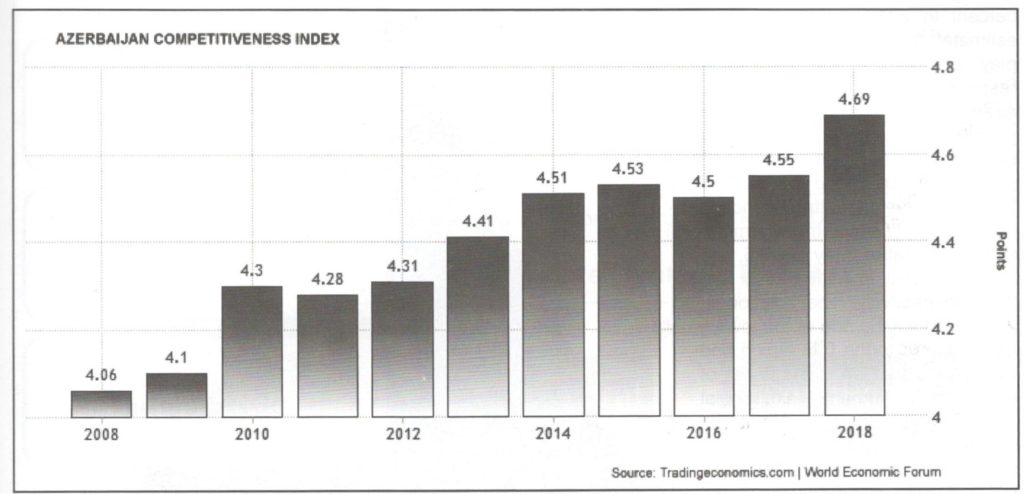
Azerbaijan’s Improved Ratings
Azerbaijan has significantly improved its position in the ranking by three indicators “Infrastructure”, “Education and Skills” and “Dynamism of Business”. It is stressed in the report that Azerbaijan is a country where social equality is ensured at the highest level in the world. Azerbaijan is the real champion of multiculturalism where every person and sect has equal rights. Its tolerance level and interfaith harmony is its real strength and essence. Azerbaijan received 100 points, being placed on the first place by the level of electricity supply to the population. Azerbaijan has retained its leading position under “environ mental impact” and “inclusive development” indicators.
Among 140 countries, Azerbaijan ranked 31st in the business dynamism rating. It was possible to achieve such a high result thanks to the economic reforms conducted by resident of Azerbaijan llham Aliyev.
Figure-lll
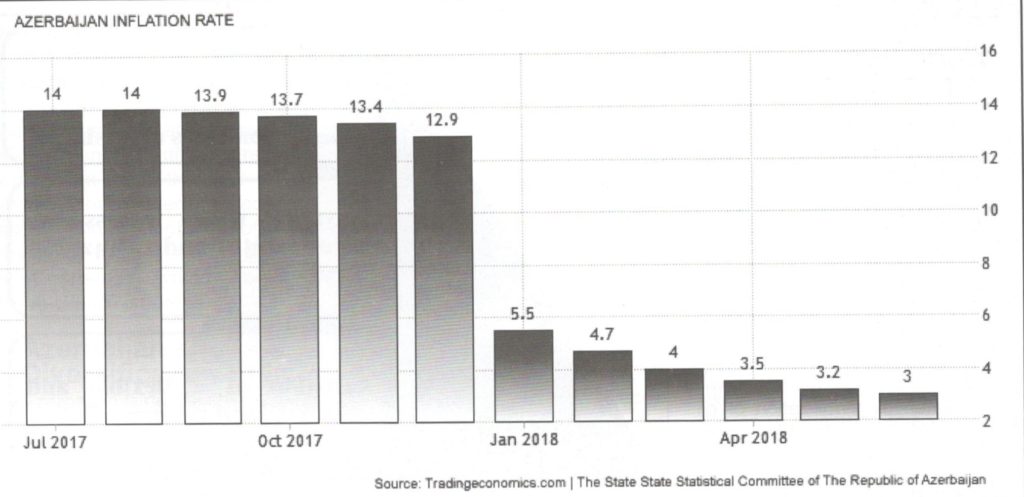
It has also been rated as “the required number of days to start a 17th business” sub-indicator place, “Regulatory and legal framework for bankruptcy” sub-indicator 17th place, “Business risks” sub-indicator 21st place, “Influence of ideas on the company” sub-indicator 25th place.
Although “Global Competitiveness Report 2018” is termed as the first report of the new generation still Azerbaijan is able to show good results in most of the indicators.
IMF Report (2018)
In its most recently published report, the IMF has forecasted the GDP growth in Azerbaijan by 1.3 percent in 2018. IMF has further estimated that during (2019-2023) it may achieve 3.6 and 2 percent, respectively Nevertheless, MZerbai1ani government expects the growth of the country’s GDP at the level of 2 percent for this year, 3.19 percent for 2019, and 3.5 percent for 2020. Due to better economic reforms and financial management, inflationary ratios may be 3.5, 3.3 and 3 percent in 2018, 2019 and 2023 respectively. The inflation in Azerbaijan will be one of the lowest as compared to the CIS region and Georgia. Azerbaijan is the avatar of economic of humanity and social development due to which it has achieved and subsequently, sustained highest position in terms of qualitative life, clean drinking water, sanitation, medications, pensions, wages and social protection in the CIS and the South Caucasus.
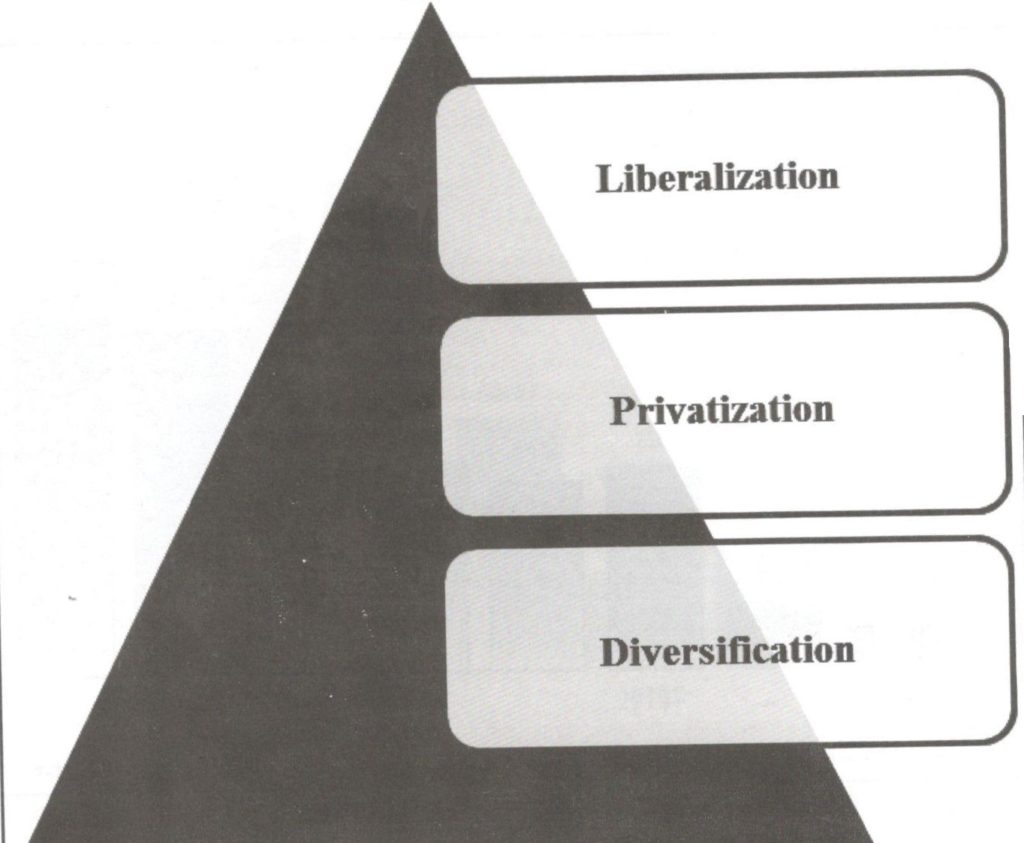
World Bank Report (2018)
Most recently, the World Bank (WB) also published its report on Azerbaijan ‘s economy which expects inflation rate in Azerbaijan to remain below 3 percent. It predicts that in the medium term, the economy of Azerbaijan will be strengthened thanks to the export of gas and the acceleration of GDP growth. Moreover, the growth of Azerbaijan’s non-oil sector, which is expected at an average level of 2.7 percent, will be facilitated by stabilization of oil prices, increased market confidence, gradual recovery of investments and improvement of the banking sector. Until 2020, the current account surplus will be 10 percent of GDP as predicted by the WB 2018.
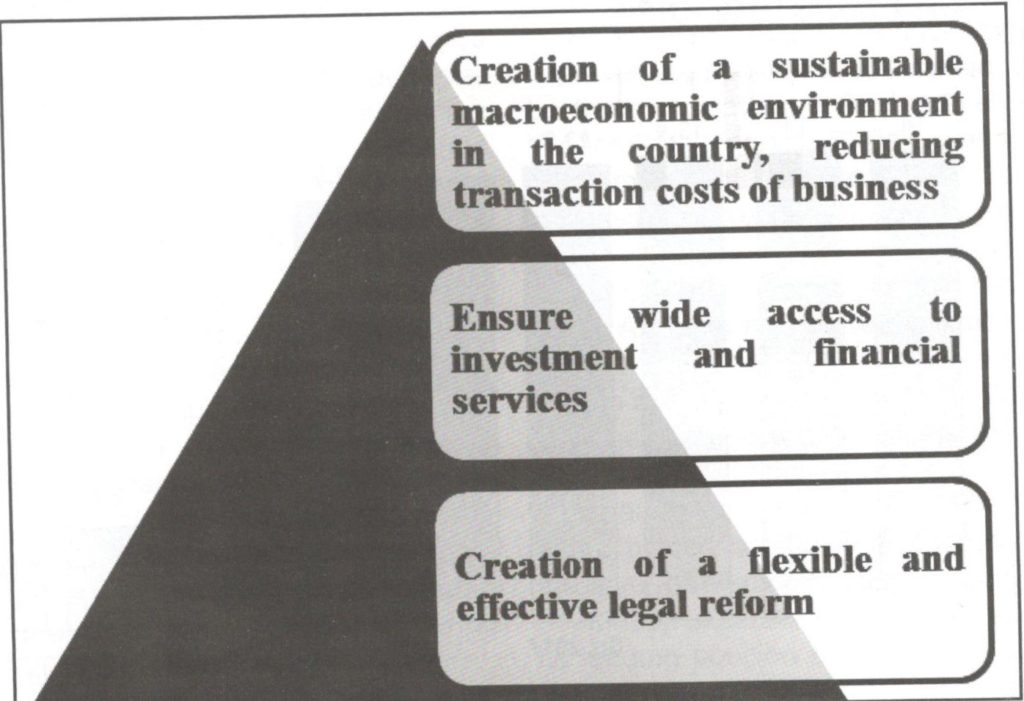
Azerbaijan Economic Model & Policy
The government of Azerbaijan has pinpointed six factors of economic development during 2018 i.e. natural resources, population growth, human capital development, institutional reforms, promotion of the development of technologies and comprehensive measures to diversify the Azerbaijani economy. Azerbaijani government has also determined the main priorities of the socio-economic development policy for (2017-2020) .
It has emphasized the provision of macroeconomic stability, development of the non-oil sector, strengthening of the competitiveness of the national economy and improvement of the business environment. The acceleration of the economic diversification, expansion of non-oil exports, increasing the country’s export potential and continuation of socially oriented policies are also among the other main priorities.
Azerbaijan ‘s macro-economy has tripled since 2003 while its industrial development has also tripled. Poverty has been controlled and has almost vanished. The poverty level, which was standing at approximately 50 percent has dropped down to 5 percent. Salaries and pensions have been increased by several times over the last 13 years. Azerbaijan also started the development of its different regions, adding that more than 1.3 million new jobs have been created as a result of implementation of state programs. It has unique development strategy which balances “Rural-Urban” progress.
Azerbaijan’s Diversification Policy
Azerbaijan is rigorously pursuing further diversification of its economy by launching various diversified but integrated initiatives to promote non-oil sectors and regional development throughout the country. It initiated a balanced regional and sectoral development drive which is now paying its dividends. According to the Europe.an Bank for Reconstruction and Development (EBRO) its economy is on the right growth path and its future prospects are solid and strong. It predicts GDP growth rising from 2.5 percent this year to 3.5 percent in 2019. Azerbaijan’s diversification of economy is primarily based on tourism, agribusiness, manufacturing, services and small and medium-size enterprises (SMEs).
| Socio-Economic Recognition | Details |
| International Agency, Positive Credit Rating for its macro-economy | Fitch Rating, Moody’s, Standard & Poor’s |
| Improved Doing Business Facilities | World Bank, International Finance Corporation |
| Leading place among CIS and regional countries | World Bank Global Competitiveness Report |
| “High human development” | UN Development Program’s Human Development report |
European Bank for Reconstruction and Development (EBRO) Report (2018)
According to EBRO during 2018 (January-July) Azerbaijan’s non-oil sectors grew much faster than the economy as a whole. Investments by the state oil fund SOFAZ, and more capital lured in from foreign investors, have upward pushed for non-oil GDP growth this year.” The sovereign wealth fund is investing outside the sector by which it is funded, to ensure the nation’s future after hydrocarbons are depleted.
International North South Transport Corridor (INSTC)
Azerbaijan is also an ideal hub of regional connectivity having modern transportation system. Its transportation infrastructure ranks high among the strategic priorities. It desires to build a North-South corridor connecting Russia, Azerbaijan and Iran, thus opening up an over land freight route between Europe and South Asia. The International North-South Transport Corridor (INSTC), a 7,200-km-long freight route connecting India, Iran, Azerbaijan and Russia via ships, rail and roads, is meant to connect Northern Europe with Southeast Asia. The INSTC is to provide an alternative to the traditional sea routes through the Suez Canal, the Mediterranean and the Baltic Sea. The corridor is planned to transport 5 million tons of cargo per year at the initial stage and more than 10 million tons of cargo in the future.
The North-South Transport Corridor is making strides towards achieving a new framework. The project has the potential to incorporate other interested states, including countries of the Caucasus, Central Asia, and Eastern Europe, and perhaps also Oman.
A new port, railways and roads are being built to fulfill President llham Aliyev ‘s aim to create a regional transport and logistics hub. It is hoped after the completion of the mega project of North-South Corridor (NSC), Azerbaijan ‘s nation al drive of diversification of economy will be further strengthened. Baku Port has been functional and operative, it serves as a hub for Eurasian-Silk Road commerce. Baku Port may be turn into a free economic zone in the near future. Investments in Baku airport will make it a hub for cargo shipment.

Mega Energy Projects
According to above figure V Azerbaijan has initiated many mega energy and transportation projects. Baku-Tbilisi-Erzurum (STE) Gas Pipeline transports gas from the Shah Deniz field to Georgia and Turkey. Whereas, Southern Gas Corridor (SGC) will transport gas extracted from Shah Deniz Stage II development from Caspian Sea to Turkey and then to Europe. The SGC consists of two further important pipelines projects i.e. Trans Anatolian Pipeline (TANAP) and Trans-Adriatic Pipeline (TAP) which will deliver Azerbaijan’s gas to European countries.
Mega Industrial Plants
Azerbaijan has various modernized industrial plants such as Sumqayit’s “Azerikimya Production Unit,” matching international standards and targeting a global market. It has ambitious plans aimed at strengthening the country’s tourism industry and it’s also working on making Azeri agriculture more productive.
The Republic of Azerbaijan entered a new era of development in 2003 since llham Aliyev’s first presidency. The last 15 years marked a paradigm shift in the economic, social, political, and cultural development of the country. Over recent years the economy of the country has more than tripled in size, and this rapid economic development can be attributed to the exploitation of hydrocarbon resources, achieved through pro duction sharing agreements (PSAs) with foreign oil companies and foreign direct investment (FDI).
Social Infrastructure Modernization
The country has made great advances in the field of social infra structure modernization. 2003 to 2017 witnessed the construction of 43 modem sports complexes and 642 hospitals, along with the building or renovation of 3,100 schools. As a result of the Nagorno-Karabakh war, the country has also had to respond to the ongoing con sequences of conflict, including the needs of over a million refugees and internally displaced persons (IDPs).
Investments in Power Infrastructure
Investments in power infrastructure in terms of generation, distribution and upgradation of the electricity grid will ensure easy and smooth supplies throughout the country. There has also been a push to upgrade telecom capabilities, which has potential to further open the market for private investments Agriculture is more liberalized, open to both local and foreign investors. Together with the new transport infrastructure will spread economic activity away from the Baku.

Azerbaijan’s Connecting Hub
Azerbaijan is the ideal connecting hub in the region. It is actively engaged with Baku-Tbilisi-Kars (BTK) Railways and Baku International Sea Trade Port. Baku-Tbilisi-Kars (BTK) Railways has an initial capacity to transport 1 million passengers and 5 million tons of freight a year. Now Azerbaijan, Georgia and Turkey have initiated to start a rail link connecting the three countries, establishing freight and passenger link between Europe and China. It is the shortest and most reliable link between Asia and Europe. It is a major step in transport interconnection linking the European Union, Turkey, Georgia, Azerbaijan and Central Asia.
Other joint projects with Kazakhstan include an undersea oil transportation pipeline from Aktau to Baku. It is hoped that the signing of the convention will further strengthen the role of Azerbaijan as an international transit country and will increase its economic power. The signing of the document has created a solid legal basis for Azerbaijan, which has a wide maritime border and is actively engaged in economic activities in the Caspian Sea.
Concluding Remarks
Since its independence substantial changes have been implemented in financial and banking sectors. Broad reforms on finance, financial credit, tax, price and customs have been introduced. Intensification of financial discipline and regulation of rate of money has also been implemented. Structural reforms paved the way for bringing down tax rates, increasing budget revenues on the account of growing the level of saving and expanding tax base, raising efficiency of budget expenses transparency and management.
Being regional expert on Azerbaijan & South Caucasus it is suggested to further liberalize the financial sector of the country. There is a huge scope and potential in the existing banking and financial system of the country. There is a huge scope for the growth of Islamic banking and finances which needs to be reconsidered and revised. There is an urgent need to introduce models of good governance and corporate management in the national banking and financial industry of the country. Foreign banks may also be permitted to operate in the country especially in the rural areas. Domestic insurance market may also be further opened for seeking FDls where currently only joint ventures with local companies are permitted. New investors/ players would provide access, for both SMEs and households, to alternative financial instruments such as guarantees, leasing and factoring.
In order to speed up the economic growth in the far-flung areas in the country it is strongly suggested to provide alternative sources of corporate funding, currently dominated by a few banks. Development of local stock exchange and capital markets would play contributory role in achieving the desired goals of socio-economic prosperity in the days to come. Diversification of currency reserves may be a good move to absorb any financial shock in the future because dollarization of economy remains high.
The most recently signed historic agreement on “Caspian Sea” would produce positive impact on Azerbaijan’s national economy and would also support its national drive of diversification of economy. It has enhanced Azerbaijan’s role as a transit country linking European markets to Central Asia’s huge reserves of oil and gas. It is predicted that proposed Trans-Caspian Pipeline would transport natural gas from Turkmenistan, linking up with the Southern Gas Corridor to carry it onward to Europe.
Azerbaijan has achieved miraculous socio-economic development due to gradual diversification of economy. Its non-oil sector has increased by 2.8 times in the last ten years. During the last 5 years the share of non-oil sector in GDP increased from 40.7 percent to 44.4 percent share of oil sector decreased from 53.8 percent to 48.5 percent in virtue of the measures directed to the development of the non-oil sector and diversification of the economy, along with promotion of material and technological base of existing facilities in these areas.
Azerbaijan has achieved an immense social development. It has successfully transformed oil capital into a human capital. It initiated diversified but integrated policy measures to further improve the education system due to which it has now achieved a knowledge-based economy. Its state education program is now rated among the best in the world. New schools, hospitals, museums, Olympic venues, cultural institutions and recreational areas are contributing to the improvement of the social life. The “ASAN xidmǝt” network, targeted social assistance, provision of low income families with housing on favorable terms and other projects are the result of the ongoing nation al social policy.
The private sector is gradually becoming the engine of Azerbaijan ‘s economy and has played an important role in increasing the country’s non-oil exports. Azerbaijan’s non-oil exports grew by 35 percent. The private sector made a big contribution to this growth, as 70 percent of non-oil exports fell to share of the private sector.
Growth of non-oil and non resource sectors of its macro-economy my is now the need of the hour. Former President and national leader Heydar Aliyev and llham Aliyev the President of Azerbaijan are the main architect of modern Azerbaijan who announced, implemented and institutionalized so many diversified but integrated reforms in different sectors of national economy. Oil strategy was successfully implemented. Infrastructural development was planned and achieved. Moreover, socio-economic prosperity, energy and food security was maintained. Private sector was strengthened and qualitative life was secured. Ultimately it had defined Azerbaijan ‘s unique position in the regional as well as world economy.
Further development of small and medium-sized businesses, which is an integral part of the successful economic policy of Azerbaijan, must be further developed. In this connection, regulation of entrepreneurial activity and use of effective coordination, enhancement of the role and competitive ness of small and medium-sized enterprises in the economy of the country, and compliance of the management system must be implemented in its true spirits as ordered by the decree of the President of Azerbaijan.
Development of small and medium enterprises (SMEs) will generate jobs, support reduction of poverty and enhance further of women empowerment in the next decade. In this connection, needed financial assistance/ loans should be provided at concessional rates from banking (banks, DFls, leasing companies etc.) and non-banking channels (micro-credit, micro-financing, community development through financial capacity building support etc.). Further development of SMEs sector would further diversify its economy, export mix and sharpen entrepreneurship among the people of Azerbaijan.
It is also a healthy development that currency reserves of the Central Bank of Azerbaijan (CSA) amounted to $5,465 .8 billion in April 2018, which is $846.5 million (18.3 per cent) more than in the same period last year. During the month, CSA reserves rose by $42.2 million. Currency reserves of CSA increased by $1.36 billion or 34.2 percent in 2017 as compared to 2016.
Azerbaijan achieved miraculous socio-economic development by initiating and implementing series of short as well as long terms socio-economic reforms in the different spheres of economy, civic and production channels. It turned poverty into production, inflation into international cooperation, unemployment into massive generation of job creation and above all decline of socio-economic development into robust socio economic growth which is now rapid and sustained too.

Azerbaijan announced a strategic road map to further strengthening of economic, banking and financial reforms, liberalization, privatization and making Azerbaijan an ideal hub of high inflows of Foreign Direct Investments (FDls), price stability, modernization of the economy, smarter production channels, and development of renewables. Ultimate objective of this strategic road map is to achieve and provide “qualitative life” to all the people of Azerbaijan through sustained socio economic development. It is a “push-forward” systematic approach of Azerbaijan’s government to be remained as one of the most attractive, competitive and tolerant country in the region and beyond.
The strategic road map will result dreams materializing of qualitative life to general masses through sustained socio-economic development. It is a forward-looking and result-oriented document which has a push-forward systematic approach of Azerbaijan’s government. It would definitely enhance its attractiveness, competitiveness being a tolerant country in the region and world alike. It out lines its foremost national priorities to be pursued for achieving high rates of GDPs, per capita income, job generation, exports, tourism and above all greater regional connectivity for a “shared prosperity”. Ultimately it will provide important impetus to large-scale reforms. It will ensure socio-economic and political stability in the country.
It pinpointed various sector for achieving the desired goals of socio economic development i.e. development of the oil and gas industry, Manufacturing and Processing of Agricultural Products, Manufacturing of Small and Medium Entrepreneurship-level Consumer Goods, Development of Heavy Industry And Machinery, Development of Specialized Tourism Industry, Development of Logistics, Development of Housing Provision at a Reasonable Price, Development of Vocational Education and Training, Development of Financial Services, Development of Communication and Information Technologies, Development of Utilities (Electricity and Thermal Energy and Water and Gas Supply).
Reforms remained constant and paramount due to which high rates of GDPs, per capita income, FDls and the last but not the least export-oriented policies were pursued. Now sustainable economic reforms carried out by President H.E. llham Aliyev meet the new challenges of the global economy. Although, weak economic growth in the region and beyond the sharp decline in oil revenue, the complicated external economic growth factors/ environment affects the country’s macroeconomic and financial stability yet its macro-economy outperformed all the regional countries and remained stable and sustainable.
Weak regional economies and more precisely US sanctions on Turkey and Iran may create some unpleasant trends in Azerbaijan’s economy. But I personally think such negative spillover repercussions should be manageable for the economy of Azerbaijan because of integrated macroeconomic policies in terms of sizable foreign exchange liquidity, boom to tourism, rampant growth to SMEs and service sectors.
Azerbaijan has a much tighter fiscal policy than most of the region al countries especially Turkey and Iran having sensible control on the exchange rate would stop any unwanted short and long-term fluctuations in the currency markets. Furthermore, Azerbaijan has the hottest real estate industry in the region due to which neighboring countries have invested in Azerbaijan. Azerbaijan bid to host EXPO 2025 has generated tremendous economic activity in the region. Hopefully to be selected for hosting Expo 2025 would surely gain from the boost to the tourist industry. In the past, Azerbaijan announced plans for space due to which it has now surpassed the gravitational force and entered into space. The sky-space is now the limit for Azerbaijan.


